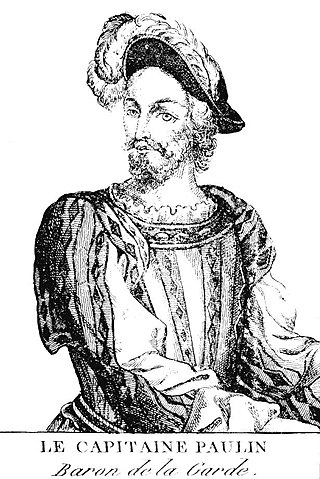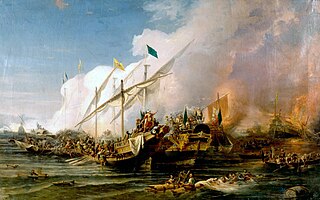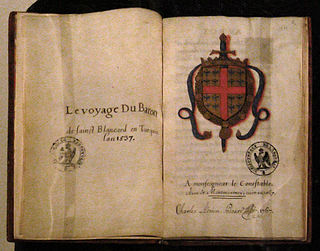
Hayreddin Barbarossa, also known as Hayreddin Pasha, Hızır Hayrettin Pasha, and simply Hızır Reis, was an Ottoman corsair and later admiral of the Ottoman Navy. Barbarossa's naval victories secured Ottoman dominance over the Mediterranean during the mid-16th century.
The Holy League of 1538 was a short-lived alliance of Christian states arranged by Pope Paul III at the urging of the Republic of Venice.
Kurtoğlu Muslihiddin Reis was the admiral of the Ottoman Empire, as well as the Sanjak Bey of Rhodes. He played an important role in the Ottoman conquests of Egypt (1517) and Rhodes (1522) during which he commanded the Ottoman naval forces. He also helped establish the Ottoman Indian Ocean Fleet based in Suez, which was later commanded by his son, Kurtoğlu Hızır Reis.
Salah Rais was the 7th King of Algiers, an Ottoman privateer and admiral. He is alternatively referred to as Sala Reis, Salih Rais, Salek Rais and Cale Arraez in several European sources, particularly in Spain, France and Italy.

The Habsburg Empire of Charles V and its allies conquered Tunis in 1535, wresting the city away from the control of the Ottoman Empire.

The siege of Nice occurred in 1543 and was part of the Italian War of 1542–46 in which Francis I and Suleiman the Magnificent collaborated as part of the Franco-Ottoman alliance against the Holy Roman Emperor Charles V, and Henry VIII of England. At that time, Nice was under the control of Charles III, Duke of Savoy, an ally of Charles V. This is part of the 1543–1544 Mediterranean campaign of Barbarossa.

The Franco-Ottoman Alliance, also known as the Franco-Turkish Alliance, was an alliance established in 1536 between the King of France Francis I and the Sultan of the Ottoman Empire Suleiman I. The strategic and sometimes tactical alliance was one of the longest-lasting and most important foreign alliances of France, and was particularly influential during the Italian Wars. The Franco-Ottoman military alliance reached its peak around 1553 during the reign Henry II of France.

Antoine Escalin des Aimars, also known as Captain Polin or Captain Paulin, later Baron de La Garde, was French ambassador to the Ottoman Empire from 1541 to 1547, and "Général des Galères" from 1544.

Jean de La Forêt, also Jean de La Forest or Jehan de la Forest, was the first official French Ambassador to the Ottoman Empire, serving from 1534 to 1537. Antonio Rincon had preceded him as an envoy to the Ottoman Empire from 1530 to 1533. When Jean de La Forêt died in Constantinople in 1537, he was succeeded by Antonio Rincon as official Ambassador.

The Invasion of Corsica of 1553 occurred when French, Ottoman, and Corsican exile forces combined to capture the island of Corsica from the Republic of Genoa.

An Ottoman embassy to France was sent in 1533 by Hayreddin Barbarossa, the Ottoman Governor of Algiers, vassal of the Ottoman Emperor Suleiman the Magnificent.

The conquest of Tunis occurred on 16 August 1534 when Hayreddin Barbarossa captured the city from the Hafsid ruler Muley Hasan.

An Ottoman embassy to France occurred in 1534, with the objective to prepare and coordinate Franco-Ottoman offensives for the next year, 1535. The embassy closely followed a first Ottoman embassy to France in 1533, as well as the Conquest of Tunis by Hayreddin Barbarossa on 16 August 1534, which marked a strong reinforcement of Ottoman positions in the Western Mediterranean.

The siege of Corfu in 1537 was led by the Ottoman Emperor Suleiman the Magnificent, against the Republic of Venice-held island of Corfu. It is part of the Ottoman–Venetian War (1537–1540), one of the numerous Ottoman–Venetian Wars of the period.

The Third Ottoman Venetian War (1537–1540) was one of the Ottoman–Venetian wars which took place during the 16th century. The war arose out of the Franco-Ottoman alliance between Francis I of France and Süleyman I of the Ottoman Empire against the Holy Roman Emperor Charles V. The initial plan between the two had been to jointly invade Italy, Francis through Lombardy in the North and Süleyman through Apulia to the South. However, the proposed invasion failed to take place.

Jean de la Vega, also Jehan de la Vega, was a French traveler and writer of the 16th century. He was a member of the fleet Bertrand d'Ornesan which collaborated with the Ottomans under the Franco-Ottoman alliance.

Jérôme Maurand was a 16th-century French priest of Antibes, who accompanied the French officer Captain Polin in conjunction with the Ottoman fleet of Barbarossa in 1544, as a part of the Franco-Ottoman alliance.

La Réale was a French Royal galley of the 16th century.

The Ottoman wintering in Toulon occurred during the winter of 1543–44, following the Franco-Ottoman Siege of Nice, as part of the combined operations under the Franco-Ottoman alliance.

The Holy League of 1535 was as ad hoc coalition of catholic states arranged by Pope Paul III at the urging of Charles V.















